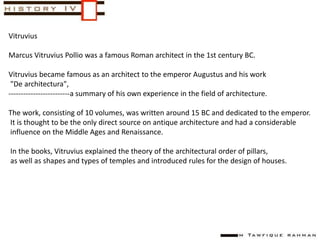Lecture 1 vitruvius
•Transferir como PPTX, PDF•
9 gostaram•5,627 visualizações
if needed to ask anything about the slide, please feel free to mail at - mirat147@hotmail.com
Denunciar
Compartilhar
Denunciar
Compartilhar

Recomendados
Recomendados
Mais conteúdo relacionado
Mais procurados
Mais procurados (20)
Complexity and contradiction in architecture by Robert venturi 

Complexity and contradiction in architecture by Robert venturi
Destaque
Destaque (20)
Semelhante a Lecture 1 vitruvius
Semelhante a Lecture 1 vitruvius (20)
(History of Architecture 2) October 2012 renaissance architecture

(History of Architecture 2) October 2012 renaissance architecture
Architectural theory based on industrial revolution1.ppt

Architectural theory based on industrial revolution1.ppt
PitchSkills Business Presentation Template - Whitespace

PitchSkills Business Presentation Template - Whitespace
A Century Of Futurist Architecture - From Theory To Reality.Pdf

A Century Of Futurist Architecture - From Theory To Reality.Pdf
Lecture 1 vitruvius
- 1. Vitruvius Marcus Vitruvius Pollio was a famous Roman architect in the 1st century BC. Vitruvius became famous as an architect to the emperor Augustus and his work "De architectura", -------------------------a summary of his own experience in the field of architecture. The work, consisting of 10 volumes, was written around 15 BC and dedicated to the emperor. It is thought to be the only direct source on antique architecture and had a considerable influence on the Middle Ages and Renaissance. In the books, Vitruvius explained the theory of the architectural order of pillars, as well as shapes and types of temples and introduced rules for the design of houses.
- 2. Alongside actual architecture, he also dealt with technical objects, e.g. the so-called "Tympanum" (for the transport of water), flour mills, waterscrews, thermal springs, sundials and various technical tools aiding construction. Great architectural writers of the 15th to 17th century, including Alberti, Vignola, Palladio and Selio based their theories on Vitruvius's "De architectura". The first printed edition of Marcus Vitruvius Pollio' work appeared in Rome in 1486, the first illustrated edition was published in 1511 Venice.
- 3. De Architectura, asserted that there were three principles of good architecture: Firmatis (Durability) - It should stand up robustly and remain in good condition. Utilitas (Utility) - It should be useful and function well for the people using it. Venustatis (Beauty) - It should delight people and raise their spirits.
- 5. Three motives may be imputed to Vitruvius in his articulation of the three ‘classic’ architectural values of firmitas, utilitas, and venustas. The first is the idea that architectural accomplishment constitutes a kind of completion, a unity brought to component parts that, on their own, are highly differential. Secondly, by inclusion of venustas, Vitrivius considers that not only the objects of architecture are important but also their ‘audiences’, and that esthetics can be considered apart from use and even solidity, even when the occupants of a building are busy enjoying its conveniences. The third Vitruvian aspiration seems to be indicated simply by the highly differential nature of the three components: that ‘architecture’, whatever it might be, is a unity that is not allowed to transcend difference but must find a certain topological congruence that cannot be ‘flattened out’ on to a map or representation
